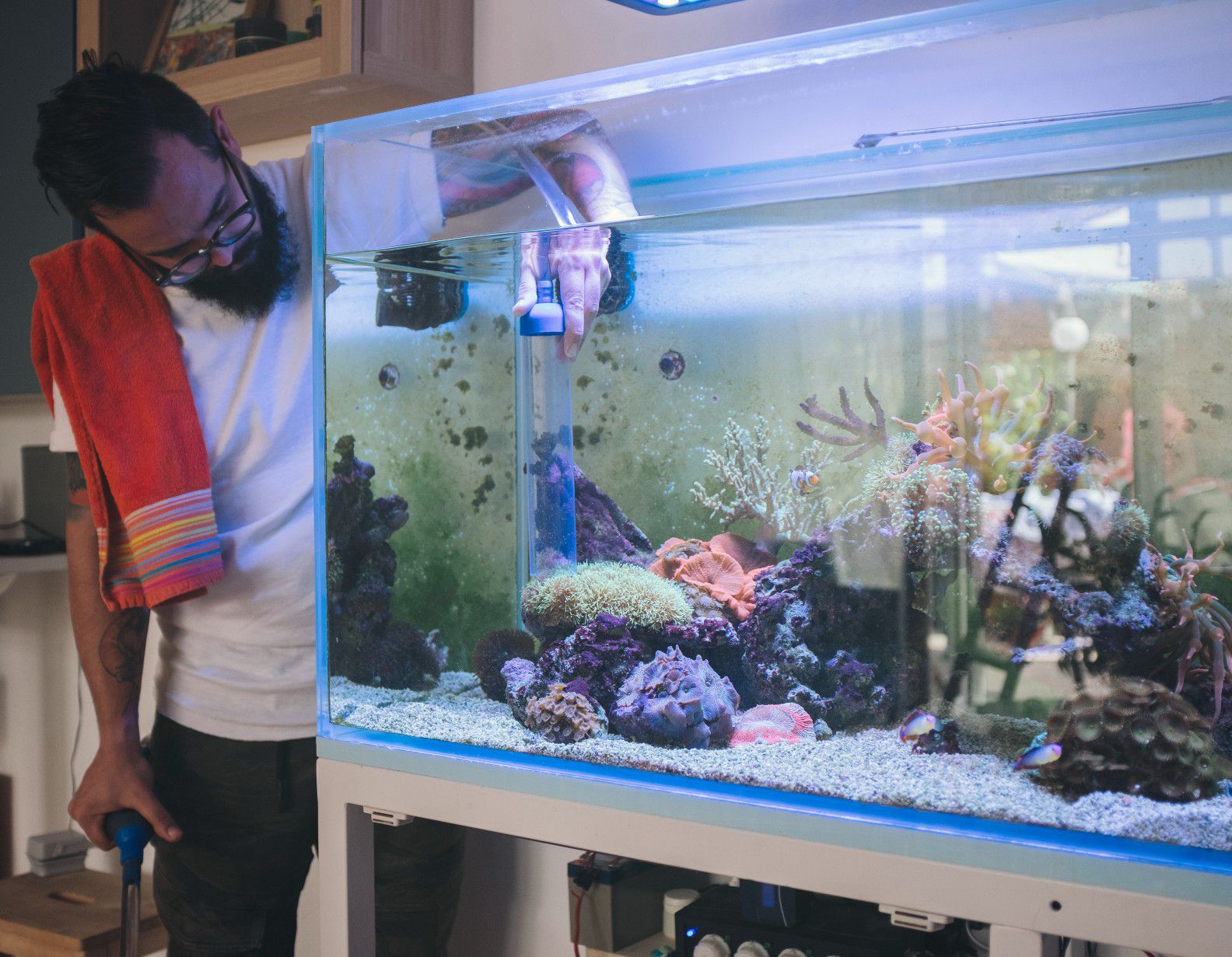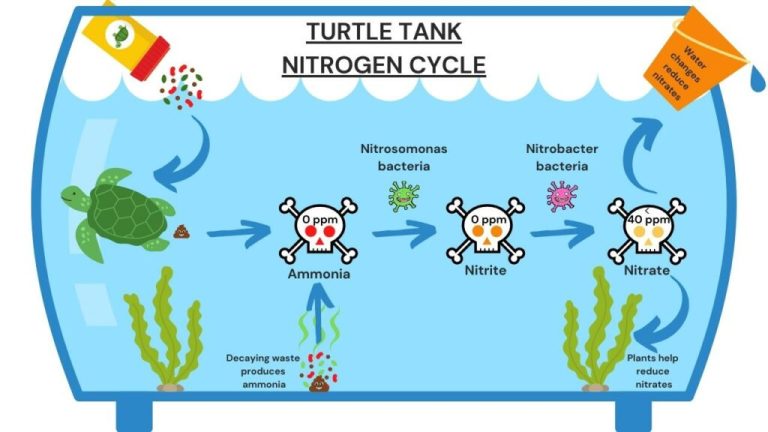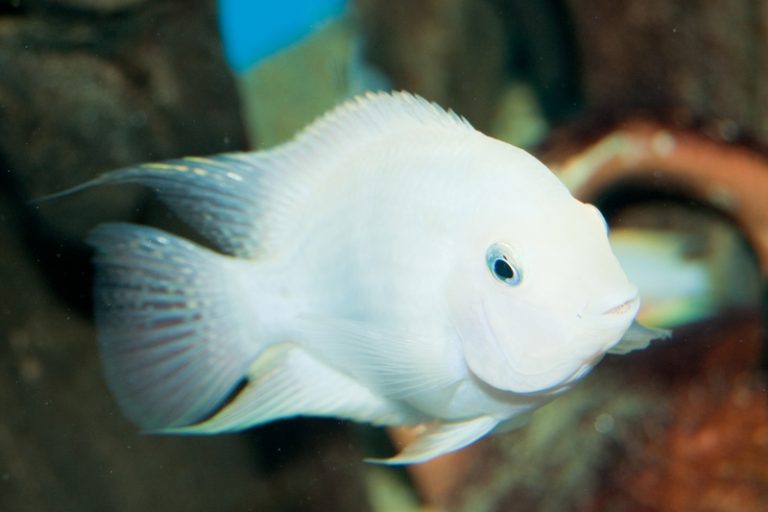How to Easily Remove Stubborn Calcium from Aquarium Walls
To remove calcium from aquarium walls, gently scrub the affected areas using a soft brush and a mixture of equal parts vinegar and water.

Credit: www.youtube.com
Understanding The Impact Of Calcium Buildup On Aquarium Walls
Calcium buildup on aquarium walls can be a common problem faced by fish enthusiasts. Understanding the impact of this buildup is crucial in maintaining a healthy and thriving aquatic environment. In this section, we will explore the problems caused by calcium buildup in aquariums, the importance of maintaining clean and clear aquarium walls, and how calcium buildup can affect the overall health of aquatic life.
The Problems Caused By Calcium Buildup In Aquariums:
- Unsightly appearance: Calcium deposits can create a white, crusty layer on the walls of the aquarium, mar a beautiful underwater landscape, and hinder visibility.
- Ph imbalance: Excessive calcium levels contribute to ph imbalance, which can be detrimental to the delicate ecosystem of your aquarium.
- Clogged filters and reduced water flow: Calcium buildup can clog filters, impeding water flow and compromising the filtration system’s efficiency.
- Decreased oxygen exchange: As calcium accumulates on the walls, it can reduce the surface area available for oxygen exchange, making it challenging for fish and plants to thrive.
The Importance Of Maintaining Clean And Clear Aquarium Walls:
- Enhanced aesthetics: Regularly cleaning and removing calcium buildup result in crystal-clear walls, allowing you to fully enjoy the vibrant colors and movements of your aquatic pets.
- Better visibility: Clean walls provide an unobstructed view of your fish, plants, and ornaments, enabling you to spot any signs of illness or distress more easily.
- Optimal light transmission: Calcium deposits can reduce the amount of light that reaches the bottom of the tank, hindering the growth of plants and potentially affecting the overall well-being of your aquatic inhabitants.
- Overall cleanliness: A clean aquarium is essential for maintaining water quality and preventing the accumulation of harmful substances that could harm the fish.
How Calcium Buildup Affects The Overall Health Of Aquatic Life:
- Damaged fins and gills: Sharp calcium deposits can cause physical harm to the sensitive fins and gills of fish, leading to infections or other health issues.
- Hindered growth and development: Calcium buildup can impede the growth and development of fish, particularly in their skeletal structure.
- Stress and behavioral changes: Poor water quality resulting from calcium buildup can induce stress in fish, leading to altered behaviors such as decreased appetite, unusual swimming patterns, or excessive hiding.
- Increased vulnerability to diseases: Accumulated calcium can create an environment conducive to the growth of harmful bacteria, parasites, and other pathogens, jeopardizing the health and well-being of your aquatic companions.
By understanding the problems caused by calcium buildup in aquariums, recognizing the importance of maintaining clean and clear walls, and acknowledging how calcium buildup affects the overall health of aquatic life, you can take the necessary steps to ensure a thriving and harmonious underwater world for your fish.
Regular cleaning and preventative measures will help to minimize calcium buildup, promoting the well-being and longevity of your aquatic pets.
Identifying The Causes Of Calcium Deposits
Calcium deposits can be a common issue in aquariums, causing cloudy and unsightly walls. If you are struggling with this problem, it’s essential to understand the causes of calcium deposits in order to effectively remove them. In this section, we will delve into the factors that contribute to the formation of calcium deposits and explore how water hardness and ph levels play a crucial role in calcium buildup.
Factors That Contribute To The Formation Of Calcium Deposits:
- High levels of calcium in the water: Excessive calcium in the water source used for the aquarium can result in the buildup of calcium deposits on the walls. This usually occurs when using tap water that is rich in minerals.
- Evaporation: As the water in the aquarium evaporates, it leaves behind minerals and impurities. Over time, these can lead to the formation of calcium deposits on the walls.
- Lack of regular maintenance: Neglecting routine cleaning and maintenance can contribute to the development of calcium deposits. Accumulated debris and organic matter provide a surface for calcium to attach and form deposits.
- Algae growth: Algae naturally produce calcium carbonate, which can contribute to the buildup of calcium deposits on the aquarium walls. If the aquarium is exposed to excessive sunlight or has poor water circulation, it may promote algae growth and subsequent calcium deposition.
How Water Hardness Affects Calcium Buildup:
- Hard water contains a higher concentration of calcium and other minerals. When this water is used in the aquarium, it increases the likelihood of calcium deposits forming on the walls.
- The hardness of the water can vary depending on the source. If you are experiencing frequent calcium buildup, testing the water hardness can help identify if this is a contributing factor.
- Regular testing and adjusting water hardness through the use of water conditioners or a reverse osmosis system can help minimize calcium buildup.
The Role Of Ph Levels In Calcium Deposition:
- Ph levels refer to the acidity or alkalinity of the water. Higher ph levels tend to promote the formation of calcium deposits.
- When the water in the aquarium has a high alkaline ph, it can lead to the precipitation of calcium carbonate, resulting in deposits on the walls.
- Maintaining a balanced ph level is important for preventing calcium buildup. Regular monitoring and adjustments using ph stabilizers can help keep the ph within the optimal range for your aquarium inhabitants.
Understanding the factors that contribute to the formation of calcium deposits is crucial for effective removal. By addressing water hardness and ph levels, you can minimize calcium buildup and maintain a clean and clear aquarium. In the following sections, we will explore various methods to safely remove calcium deposits and prevent their recurrence.
Effective Techniques For Removing Calcium Deposits
Regular maintenance and prevention techniques:
- Performing regular water changes: Regularly changing the water in your aquarium can help prevent calcium buildup on the walls. It will reduce the levels of dissolved minerals in the water, minimizing the formation of calcium deposits.
- Scrubbing the walls: Using a non-abrasive scrubber or a soft-bristled brush, gently scrub the aquarium walls to remove any visible calcium deposits. This should be done as part of your regular cleaning routine to prevent the deposits from becoming stubborn and hard to remove.
Using natural remedies to remove calcium deposits:
- Vinegar solution: A vinegar solution is an effective and natural way to remove calcium deposits. Mix equal parts of white vinegar and water, and apply the solution to the affected areas. Let it sit for a few minutes before scrubbing the walls with a soft brush. Rinse thoroughly to remove any vinegar residue.
- Lemon juice: Lemon juice contains citric acid, which is known for its ability to dissolve calcium deposits. Squeeze fresh lemon juice onto a sponge or cloth and apply it to the deposits. Allow it to sit for a few minutes, then scrub gently and rinse well.
Commercial products and their effectiveness in removing stubborn calcium:
- Aquarium glass cleaners: There are specially formulated aquarium glass cleaners available in the market that are designed to remove tough calcium deposits. These cleaners usually come in spray form and can quickly dissolve and remove the deposits without harming the aquarium inhabitants. Follow the instructions on the product label for best results.
- Calcium removers: Certain commercial products are specifically designed to remove calcium deposits in aquariums. These removers typically contain chemicals that break down the calcium buildup, making it easier to scrub away. Always read the product instructions and safety precautions before using.
Remember, prevention is key to reducing calcium deposits in your aquarium. Regular maintenance, routine cleaning, and using natural or commercial products as needed will help keep your aquarium walls clean and free of calcium deposits, ensuring a healthy and visually pleasing environment for your aquatic pets.
Natural Remedies For Removing Calcium Deposits
Vinegar: A Versatile And Eco-Friendly Option For Removing Calcium Buildup
Vinegar is an excellent natural remedy for getting rid of calcium deposits on your aquarium walls. Not only is it versatile and easy to find, but it’s also an eco-friendly option that won’t harm your aquatic friends. Here are the key points to know about using vinegar as a cleaning solution:
- Vinegar is highly acidic, making it effective at breaking down and dissolving calcium deposits.
- To use vinegar, mix equal parts water and vinegar in a spray bottle.
- Spray the solution onto the affected areas of your aquarium walls and let it sit for a few minutes.
- Use a soft sponge or cloth to gently scrub the walls and remove the loosened calcium deposits.
- Rinse the walls thoroughly with clean water to remove any residual vinegar.
- Vinegar may give off a strong smell, but it will dissipate quickly once you rinse the aquarium.
Remember to avoid using vinegar on any materials that can react negatively to acid, such as marble or certain types of sealants. Always test a small, inconspicuous area first before applying vinegar to the entire aquarium. Vinegar is a cost-effective and environmentally friendly choice for keeping your aquarium walls clean and free from calcium buildup.
Lemon Juice: A Cost-Effective And Natural Alternative To Harsh Chemicals
If you’re looking for a natural and cost-effective solution to remove calcium deposits from your aquarium walls, lemon juice is a great option. Here are the key points to know about using lemon juice as a cleaning agent:
- Lemon juice contains citric acid, which is effective in breaking down calcium deposits.
- Squeeze fresh lemon juice and dilute it with an equal amount of water.
- Apply the lemon juice solution to the affected areas of your aquarium walls and let it sit for a few minutes.
- Use a soft sponge or cloth to gently scrub the walls and remove the loosened calcium deposits.
- Rinse the walls thoroughly with clean water to remove any residual lemon juice.
Lemon juice not only helps in removing calcium deposits but also leaves your aquarium smelling fresh and clean. It’s a natural alternative to harsh chemicals that may be harmful to your aquatic pets. Just like with vinegar, make sure to test a small area first and avoid using lemon juice on sensitive materials.
Baking Soda: A Gentle Abrasive For Removing Calcium Without Damaging The Aquarium Walls
When it comes to removing calcium deposits from your aquarium walls, baking soda is a gentle yet effective option. Here’s why baking soda is a great choice and how to use it properly:
- Baking soda acts as a mild abrasive that can help loosen and remove calcium buildup without damaging the walls of your aquarium.
- Make a paste by mixing baking soda with a small amount of water.
- Apply the paste to a soft sponge or cloth and gently scrub the affected areas.
- Rinse the walls thoroughly with clean water to remove any residue.
- Baking soda is safe to use on various aquarium materials, but it’s always a good idea to test a small area first.
Using baking soda is not only effective at removing calcium deposits but also safe for your aquatic pets. It’s a gentle solution that won’t harm the delicate ecosystem of your aquarium. Remember, prevention is key to minimizing calcium buildup, so regular cleaning and proper maintenance are essential for a healthy aquarium environment.
Commercial Products For Removing Stubborn Calcium Deposits
Removing calcium deposits from aquarium walls can be a challenging task, especially when they become stubborn and difficult to eliminate. Luckily, there are several commercial products available in the market that are specifically designed to tackle these stubborn calcium deposits.
In this section, we will review popular calcium removers, compare their effectiveness, ease of use, and safety, and recommend the best products for different types of calcium buildup.
Review Of Popular Calcium Removers Available In The Market:
- Product a: This calcium remover is highly effective in breaking down calcium deposits and dissolving them completely. It is also safe to use for both glass and acrylic aquarium walls. The product comes in a convenient spray bottle, making it easy to apply directly to the affected areas.
- Product b: If you are looking for a calcium remover that is gentle yet powerful, product b is a great choice. It effectively removes calcium deposits without harming the aquatic life in your aquarium. This product is also safe to use on various types of aquarium walls.
- Product c: If you have a particularly stubborn calcium buildup that seems impossible to remove, product c is the solution for you. This heavy-duty calcium remover is specially formulated to dissolve and eliminate even the toughest calcium deposits. It is important to use this product cautiously and follow the instructions carefully.
Comparing Effectiveness, Ease Of Use, And Safety Of Different Products:
- Effectiveness: Product a and product c are highly effective in removing stubborn calcium deposits, while product b is more gentle and suitable for less severe buildup.
- Ease of use: All three products are designed for easy application. Product a and product c come in spray bottles, allowing you to target specific areas, while product b can be applied using a cloth or sponge.
- Safety: Product a and product b are safe to use on various types of aquarium walls, including glass and acrylic. However, product c should be used with caution due to its strong formula.
Recommended Products For Different Types Of Calcium Buildup:
- Mild buildup: For mild calcium deposits, product b is recommended. Its gentle yet effective formula will remove the deposits without causing harm to your aquatic life.
- Moderate buildup: If you are dealing with moderate calcium buildup, both product a and product b can be used. Product a is more effective for stubborn deposits, while product b is suitable for regular maintenance.
- Heavy buildup: For heavy and stubborn calcium deposits, product c is the best choice. However, it is essential to follow the instructions carefully and take necessary precautions to protect the aquatic life in your aquarium.
By using these commercial products, you can easily remove stubborn calcium deposits from your aquarium walls, ensuring a clean and healthy environment for your aquatic pets. Remember to choose the product that matches the severity of calcium buildup in your aquarium, and always prioritize the safety of your fish and other aquatic organisms.
Step-By-Step Guide To Removing Stubborn Calcium Deposits
Aquariums bring tranquility and beauty to any space, but maintaining their crystal-clear walls can be a challenge. Over time, calcium deposits can develop, giving an unsightly appearance to your aquatic paradise. However, fear not! With a little know-how and the right tools, you can easily remove those stubborn calcium deposits and restore the sparkling beauty of your aquarium.
In this step-by-step guide, we’ll walk you through the process of removing calcium deposits, ensuring a safe and effective cleaning process.
Preparing The Aquarium For Cleaning
Before diving into the actual cleaning process, it’s crucial to prepare your aquarium properly. Follow these steps to ensure the best results:
- Empty the aquarium partially, leaving enough water to keep fish and other inhabitants comfortable.
- Gently remove any plants, decorations, or live rock from the tank.
- Carefully unplug any electrical equipment, such as heaters and filters, and place them in a secure location away from water.
Choosing The Most Suitable Method For Removing Calcium Deposits
There are several methods you can use to tackle those stubborn calcium deposits. Consider the following options and choose the one that suits your needs best:
- Vinegar solution: Mix equal parts of water and vinegar in a spray bottle. This gentle acid will dissolve the calcium deposits without harming your aquarium.
- Scrubbing pads: Use a non-abrasive scrubbing pad to gently scrub away the calcium deposits. Be cautious not to use any rough or abrasive materials that could scratch the glass or acrylic surface.
- Commercial calcium removers: There are various commercial products available specifically designed for removing calcium deposits from aquarium walls. Follow the instructions provided on the product for best results.
Performing The Cleaning Process Safely And Effectively
Now that you’re fully prepared and have chosen the most suitable method, it’s time to remove those stubborn calcium deposits. Follow these steps to ensure a safe and effective cleaning process:
- Spray the vinegar solution directly onto the affected areas or apply the chosen cleaning product according to the instructions.
- Allow the solution to sit for a few minutes to penetrate and dissolve the calcium deposits.
- Gently scrub the walls with a non-abrasive scrubbing pad or a soft cloth, applying light pressure.
- Rinse the walls thoroughly with clean water to remove any residue or cleaning product.
- Carefully place the decorations, plants, and live rock back into the tank once the walls are completely clean.
- Reconnect any electrical equipment and ensure everything is functioning properly before adding the fish back into the tank.
By following these simple steps, you can say goodbye to unsightly calcium deposits and hello to a beautiful, crystal-clear aquarium. Remember to perform regular maintenance to prevent future buildup and keep your underwater oasis looking its best. Happy cleaning!
Preventing Future Calcium Buildup In Aquariums
Proper aquarium maintenance to prevent calcium deposits:
- Regular cleaning of the aquarium walls using a soft sponge or scraper to remove any existing calcium buildup.
- Perform water changes at least once a week to keep the water quality in check and reduce the chances of calcium accumulation.
- Ensure proper filtration in the aquarium to remove impurities and maintain a balanced ecosystem.
- Avoid overfeeding the fish, as excess food can contribute to increased calcium levels in the water.
- Use ro (reverse osmosis) or distilled water for water changes to minimize the concentration of minerals responsible for calcium buildup.
Best practices to ensure clean and clear aquarium walls:
- Regularly brush off any algae or debris that settle on the walls using a soft brush or sponge.
- Maintain a consistent water temperature within the aquarium to discourage the growth of algae, which can contribute to calcium deposits.
- Monitor the lighting conditions in the aquarium, as excessive light can promote algae growth and increase the likelihood of calcium buildup.
- Consider adding snails or other algae-eating organisms in the aquarium to naturally control algae growth on the walls.
- Avoid using cleaning products that contain chemicals that may harm the fish or disrupt the balance of the aquarium ecosystem.
Regular monitoring and adjustment of water parameters to prevent calcium buildup:
- Test the water regularly using aquarium water test kits to monitor the ph, hardness, and alkalinity levels.
- Adjust the water parameters accordingly by adding appropriate supplements or adjusting the filtration system to maintain optimal conditions.
- Regularly check and clean the filter to ensure proper functioning and avoid clogging, which can contribute to mineral buildup.
- Keep a consistent schedule for checking and adjusting water parameters to prevent excessive calcium accumulation.
By following these practices, you can effectively prevent future calcium buildup in your aquarium, ensuring clean and clear walls for your fish and aquatic plants. Remember that regular maintenance and monitoring play a key role in maintaining a healthy and visually appealing aquarium environment.
Frequently Asked Questions Of How To Remove Calcium From Aquarium Walls
How Does Calcium Build Up On Aquarium Walls?
Calcium builds up on aquarium walls due to the presence of hard water and mineral deposits.
Why Is It Important To Remove Calcium From Aquarium Walls?
Removing calcium from aquarium walls is important to maintain a clean and healthy environment for the fish and aquatic plants.
What Are The Risks Of Leaving Calcium Deposits On The Aquarium Walls?
Leaving calcium deposits on the aquarium walls can lead to clouded water, reduced oxygen levels, and the growth of harmful bacteria or algae.
What Are Effective Ways To Remove Calcium From Aquarium Walls?
Effective methods to remove calcium from aquarium walls include using vinegar, a scraping tool, or a commercial aquarium cleaner specifically designed for calcium removal.
Conclusion
To maintain a clean and healthy aquarium, it’s essential to tackle the pesky issue of calcium buildup on the walls. By following the simple steps outlined in this blog post, you can effortlessly remove calcium deposits and ensure the wellbeing of your aquatic pets.
First, gather your supplies: a soft sponge or brush, vinegar, and warm water. Then, start by draining a portion of the tank and carefully scrubbing the walls with the sponge or brush. Next, create a mixture of vinegar and warm water, and use it to soak the affected areas.
After a few minutes, scrub off any remaining residue. Remember to rinse the walls thoroughly before refilling the aquarium. Regular maintenance, including scheduled cleanings and water changes, will help prevent future calcium buildup. By implementing these strategies, you can keep your aquarium walls pristine and create a thriving environment for your beloved fish.






